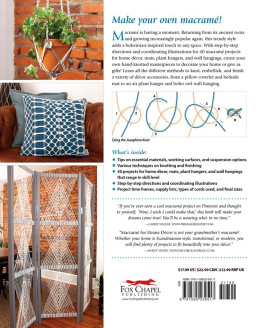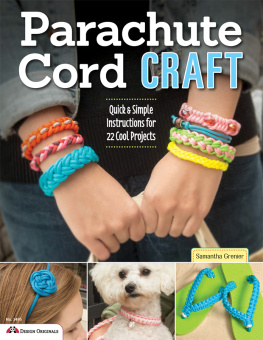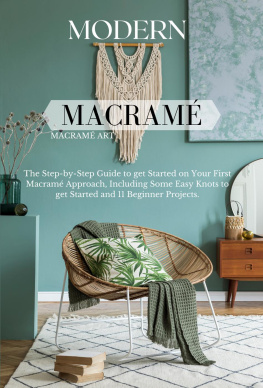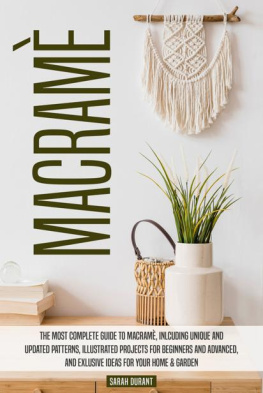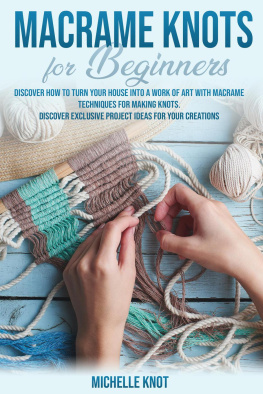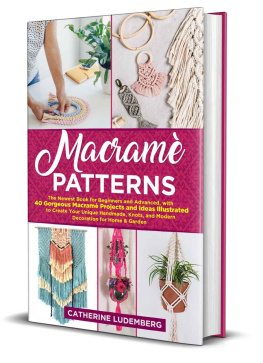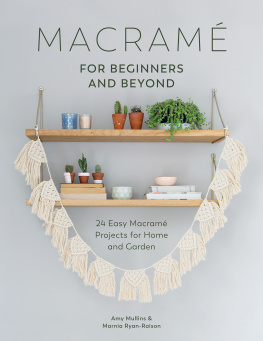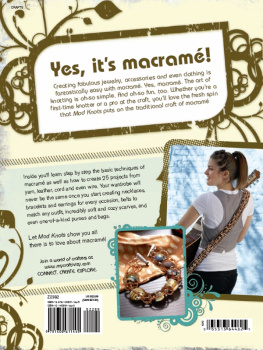Contents
Guide


2019 by Samantha Grenier and Fox Chapel Publishing Company, Inc., 903 Square Street, Mount Joy, PA 17552.
Macram for Home Dcor is an original work, first published in 2019 by Fox Chapel Publishing Company, Inc. The patterns contained herein are copyrighted by the author. Readers may make copies of these patterns for personal use. The patterns themselves, however, are not to be duplicated for resale or distribution under any circumstances. Any such copying is a violation of copyright law.
Print ISBN 978-1-56523-951-7
eISBN: 978-1-60765-544-2
The Cataloging-in-Publication Data is on file with the Library of Congress.
Photos from ).
Project photography by Mike Mihalo.
Author photo on ).
A special thank you to the Poplar Place (@poplar.place.lancaster) for allowing the use of their beautiful home to style all project photography.
To learn more about the other great books from Fox Chapel Publishing, or to find a retailer near you, call toll-free 800-457-9112 or visit us at www.FoxChapelPublishing.com.
We are always looking for talented authors. To submit an idea, please send a brief inquiry to .

Contents


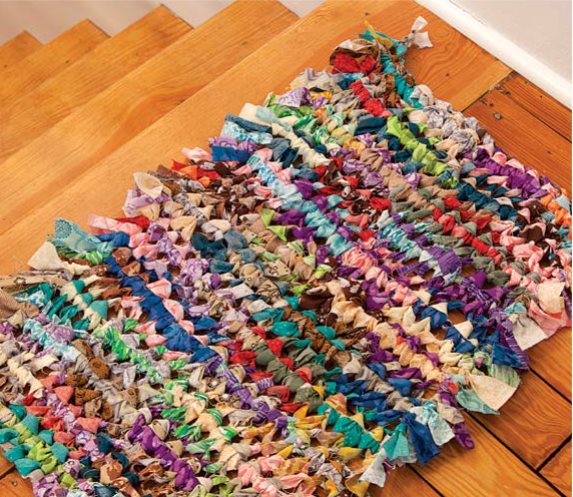
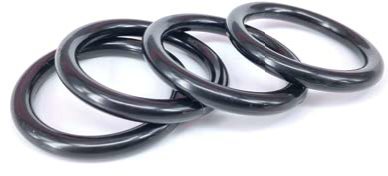


Introduction
Macram has some extensive ancient roots, but it went into dormancy after a brief craft boom in the 1970s. Sure, sure, there have always been a few knot tyers around, but the general focus turned to knitting and crochet, then onto making cute and kitschy plush toys. Only recently has macram been creeping back onto the scene.
Fancy materials are not required for macram. It doesnt need to be expensive either. Cotton is a favorite material of mine and many other knot tyers out there, but it can be pricey. There are alternatives, such as poly blends, hemp, or jute. If the project is not going to bear any weight (such as with a wall hanging), yarns may be used as a substitute. In this book, I list a few alternate materials that can be used project-to-project. The main objective for this book is that something beautiful can be made with materials sourced inexpensively and locally.
NOTE TO BEGINNERS
Tackle any project! Sit down with a couple rolls of cotton crochet yarn and test out each knot. The more you practice, the easier the projects will be.
NOTE ABOUT THE DIFFICULTY LEVEL
I ranked these projects from level 1 to level 3 based on the quantity of knots used and commitment time required to complete. None of the projects in this book are especially difficult to pull off because all the knots practiced on their own are straightforward.
Knotty Level 1 = Project can be completed in a couple hours (no more than 4) and/or only requires 1 to 2 knots.
Knotty Level 2 = Project can be completed in an afternoon (4 to 8 hours) and/or requires 2 to 4 or more knots.
Knotty Level 3 = Project can be completed over a weekend (minimally 12 hours) or longer, and/or requires 3 or more knots.
KNOTTING WITH CORD
I use both universal yarn weights and cord diameters throughout this book. To measure the cord thickness, hold a ruler across the cord to capture the diameter.
When working with longer lengths of cord, form butterfly infinity bundles to prevent tangling. This will also shorten the length of working strands so that youre not endlessly tugging on a piece of string to complete a single knot.



TENSILE STRENGTH
Tensile strength refers to how much weight a cord can bear before tearing. This is something to keep in mind while making plant hangers and swings. Hangers are typically suspending the weight of whatever its hanging. When suspending a plant, bear in mind the weight of the potted specimen when its watered, plus the weight of the pot. As a safety precaution, it is best to keep potted plants under 12" (30.48cm) wide. Suspending the hanger from a stable hook is a must, too. The plant hanger depends on the stability of the ceiling mount just as much as the strength of the cord itself.
Most cords purchased through hobby and craft shops dont offer tensile weight notations, but recommendations are noted for each project in this book. Suggestions are often noted for type of cord (such as acrylic yarn or cotton braid) and either the yarn weight (worsted, bulky, etc.) or thickness measurement. Projects using thinner cords often require a number of strands that will be combined with knotting or braiding to stabilize the finished piece.
Supplies
Working Surfaces and Suspension Options
Project Boards: Typically pre-labeled with measurements, these boards are quite handy. Some are hard and sturdy, some are soft and foamy, while others are self-healing. Project boards are a necessity if your project requires stability. They usually take tape and pins equally well. Sometimes they can be limiting by scale. Often, they are best to use when working on a smaller scale, such as with jewelry projects. The grid and measurements help keep patterns consistent, especially while tying netting and straight rows.
For the projects in this book, I used a large (3' x 3' [1 x 1m]) corkboard purchased from a local craft shop. It doesn't have a preprinted grid, but it is large enough to keep projects neat and stable as I worked.
Foam Core and Cardboard: Need a substitute for to a project board? Foam core and cardboard may be handy. They are not self-healing and may not keep the pins super steady, but measurements can be added by hand and they are often available at a moments notice. Just be sure when using thinner boards and foam core that you dont pierce the pins straight through the back of your board. That will result in an ouch! Pins may not always be necessary, however.
Pillows:

